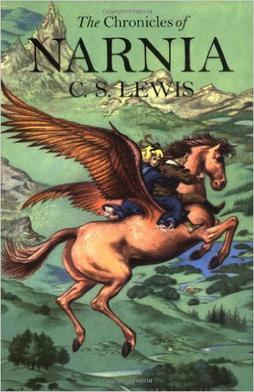The Chronicles of Narnia
Series of children's fantasy novels by C. S. Lewis
The Chronicles of Narnia
| Author | C. S. Lewis |
|---|---|
| Original title | |
| Translator | |
| Illustrator | Pauline Baynes |
| Cover artist | |
| Country | United Kingdom |
| Language | English |
| Genre | Fantasy, Children's literature |
| Publisher | Geoffrey Bles |
Lua error in package.lua at line 80: module 'strict' not found.
The Chronicles of Narnia is a series of seven fantasy novels by C. S. Lewis. Written between 1949 and 1954 and illustrated by Pauline Baynes, the series is considered a classic of children's literature and is the author's best-known work, having sold over 100 million copies in 47 languages.
Plot Overview[edit | edit source]
The series is set in the fictional realm of Narnia, a fantasy world of magic, mythical beasts, and talking animals. The protagonists are children from the real world who are magically transported to Narnia, where they play central roles in the unfolding history of that world.
The Lion, the Witch and the Wardrobe[edit | edit source]
The first book published, The Lion, the Witch and the Wardrobe, introduces the Pevensie siblings—Peter, Susan, Edmund, and Lucy—who discover the world of Narnia through a magical wardrobe.
Prince Caspian[edit | edit source]
In Prince Caspian, the Pevensie siblings return to Narnia to help Prince Caspian reclaim his throne from his evil uncle, King Miraz.
The Voyage of the Dawn Treader[edit | edit source]
The Voyage of the Dawn Treader follows Edmund and Lucy Pevensie, along with their cousin Eustace Scrubb, as they join King Caspian on a sea voyage to the edge of the world.
The Silver Chair[edit | edit source]
In The Silver Chair, Eustace Scrubb and his schoolmate Jill Pole are called to Narnia to rescue Prince Rilian, the son of King Caspian, who has been kidnapped.
The Horse and His Boy[edit | edit source]
The Horse and His Boy is set during the reign of the Pevensies in Narnia and follows the story of a young boy named Shasta and a talking horse named Bree as they journey to Narnia and the North.
The Magician's Nephew[edit | edit source]
The Magician's Nephew serves as a prequel to the series, explaining the origins of Narnia and how the wardrobe in The Lion, the Witch and the Wardrobe came to be.
The Last Battle[edit | edit source]
The Last Battle brings the series to a close with the final battle between the forces of good and evil in Narnia, leading to the end of the world and the beginning of a new one.
Themes[edit | edit source]
The series explores themes of Christian allegory, morality, and the battle between good and evil. Lewis's Christian beliefs are reflected in the narrative, particularly in the character of Aslan, who represents Jesus Christ.
Adaptations[edit | edit source]
The Chronicles of Narnia has been adapted for radio, television, stage, and film. The most notable adaptations include the BBC television series in the late 1980s and the more recent film series produced by Walt Disney Pictures and Walden Media.
Related Pages[edit | edit source]
- C. S. Lewis
- Aslan
- Narnia (world)
- The Lion, the Witch and the Wardrobe
- Prince Caspian
- The Voyage of the Dawn Treader
- The Silver Chair
- The Horse and His Boy
- The Magician's Nephew
- The Last Battle
Categories[edit | edit source]
Template:Chronicles of Narnia Template:CS Lewis
Search WikiMD
Ad.Tired of being Overweight? Try W8MD's NYC physician weight loss.
Semaglutide (Ozempic / Wegovy and Tirzepatide (Mounjaro / Zepbound) available. Call 718 946 5500.
Advertise on WikiMD
|
WikiMD's Wellness Encyclopedia |
| Let Food Be Thy Medicine Medicine Thy Food - Hippocrates |
Translate this page: - East Asian
中文,
日本,
한국어,
South Asian
हिन्दी,
தமிழ்,
తెలుగు,
Urdu,
ಕನ್ನಡ,
Southeast Asian
Indonesian,
Vietnamese,
Thai,
မြန်မာဘာသာ,
বাংলা
European
español,
Deutsch,
français,
Greek,
português do Brasil,
polski,
română,
русский,
Nederlands,
norsk,
svenska,
suomi,
Italian
Middle Eastern & African
عربى,
Turkish,
Persian,
Hebrew,
Afrikaans,
isiZulu,
Kiswahili,
Other
Bulgarian,
Hungarian,
Czech,
Swedish,
മലയാളം,
मराठी,
ਪੰਜਾਬੀ,
ગુજરાતી,
Portuguese,
Ukrainian
Medical Disclaimer: WikiMD is not a substitute for professional medical advice. The information on WikiMD is provided as an information resource only, may be incorrect, outdated or misleading, and is not to be used or relied on for any diagnostic or treatment purposes. Please consult your health care provider before making any healthcare decisions or for guidance about a specific medical condition. WikiMD expressly disclaims responsibility, and shall have no liability, for any damages, loss, injury, or liability whatsoever suffered as a result of your reliance on the information contained in this site. By visiting this site you agree to the foregoing terms and conditions, which may from time to time be changed or supplemented by WikiMD. If you do not agree to the foregoing terms and conditions, you should not enter or use this site. See full disclaimer.
Credits:Most images are courtesy of Wikimedia commons, and templates, categories Wikipedia, licensed under CC BY SA or similar.
Contributors: Prab R. Tumpati, MD



